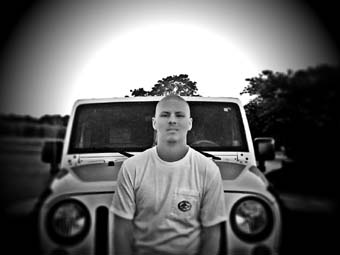
Fighting for Life: A Tribute to Cody Hayes
| published September 28, 2015 |
By Jennifer Walker-James, Thursday Review features writer
They say you never know how strong you really are until being strong is the only choice you have. And just like the vessels that carry it, strength itself, comes in many different shapes and forms. Sometimes, the greatest amount of strength is carried within the tiniest of packages. And it is often that we call the sources of this strength our hero. Everyone has one. But not everyone gets to meet them. Frank and Alicia Hayes not only got to meet their hero; they gave birth to him.
September is Childhood Cancer Awareness month. This month, alone, over 14,000 children across America will be diagnosed with some form of cancer; every 3 minutes, a set of parents will hear the devastating news that no mother or father should ever have to hear. According to the National Cancer Institute’s website, approximately 1 in 285 children in the U.S. will be diagnosed with cancer before their 20th birthday. It remains the leading cause of death by disease for children in America.
Reading the statistics, one may still be thinking that this type of thing only happens to other people—and that it’ll never affect them. Once upon a time, this was the case for Frank and Alicia Hayes. Never in their wildest dreams did they ever imagine that this horrible monster would ever affect them, let alone, take away their only son, Cody, just three weeks after his 17th birthday. In honor of their son, Frank and Alicia have come forward to share Cody’s story in hopes that it will promote further awareness of the deadly disease known as cancer.
Before his diagnosis, Cody was a typical sixteen year old boy from the sleepy, breeze-through southern town of Ashford, Alabama. He played football for the Ashford High School Yellow Jackets up until his junior year when he decided to take some time off before returning to the field his senior year—one of Cody’s many plans that would never see fruition. He also played baseball. His jersey, Number 6, was often used synonymously when referencing his campaign against cancer. His favorite team was the University of Alabama Crimson Tide. His favorite sunglasses were Ray-Bans. And his favorite people, of course, were his friends—of those he had plenty. But more than anything, Cody loved God and his family.
October, 2013 started out like any other for the young Ashford High School junior, but by the end of the first week, life would take a drastic turn for Cody and his family when he was diagnosed with Acute Myeloid Leukemia. In the blink of an eye, the Hayes family was no longer reading the statistics of childhood cancer; they were living them.
Mowing yards for extra cash, Cody nor his parents weren’t surprised when he first started showing symptoms which were very consistent with allergies or a possible sinus infection.
“He was tired a lot, but so are most teenagers, we thought. And he cut grass so we assumed that maybe his allergies were bothering him.” Alicia explains, “We kept treating his symptoms with over-the-counter sinus-allergy medications. At first, they worked so we thought that was all it was.”
Despite showing initial improvement, Cody’s symptoms slowly worsened. Thursday, October 3, 2013, he first reported his throat being sore. “That Friday, he called me to come pick him up from school,” Alicia says, “That night, he wanted to go somewhere and I wouldn’t let him because if he had to come home from school, he didn’t need to be out and about,” she adds.
Saturday, October 5th, Alicia and Frank had planned to take Cody to the doctor, but he pleaded with them to wait until he got finished cutting his customers’ grass that morning. “When he came in, he had no fever, but just felt yucky and wanted to take a nap,” his mother explains.
“He kept complaining about his neck hurting and a lump where his lymph nodes were,” Cody’s father, Frank, adds. “We just assumed his lymph nodes were swollen due to him being sick with a sinus infection or something.”
“We figured it might be turning into strep so that Sunday, October 6th, we finally took him to First Med [a large, popular walk-in doctors' office] in Dothan that morning.” Alicia’s voice starts to shake, “They tested him for strep and mono. And they had to draw blood for mono, and that’s when they realized his white blood cells were too high. They immediately sent us to Flowers Hospital.”
What started out as a simple trip to the doctor for what they thought was a common ailment resulting from the southern harvest, now marked the beginning of a life-altering journey. “On the way from First Med to Flowers, Cody kept saying ‘There’s no way I have cancer. There’s just no way…,’ He had a lot of denial, at first,” Alicia recalls. But after more testing confirmed their worst fears, Alicia, Frank, and Cody were rushed to Children’s Hospital in Birmingham. There, he would undergo ten days of treatment—a measure of protocol for all pediatric cancer patients—for Acute Myeloid Leukemia.
Acute Myeloid Leukemia, or AML, as it is often referenced, is a cancer of the myeloid line of the blood cells. The term, “myeloid,” is derived from the word “myelogenous” and is often used to describe progenitor cells for granulocytes, monocytes, erythrocytes, and platelets. AML is characterized by the rapid growth of abnormal white blood cells that accumulate in the bone marrow and interfere with the production of normal blood cells. Symptoms of AML include, but aren’t limited to fatigue, shortness of breath, easy bruising and bleeding, and increased risk of infection. Despite several risk factors and chromosomal abnormalities being identified, the specific cause for its presence is still unclear. Treatment for AML typically involves two phases of chemotherapy—remission induction (often called induction), and post-remission therapy. But because treatments for AML usually require immediate action, other types of treatment may also begin even before chemo had begun going to work.
Further complicating Cody’s treatment option was the fact that he was allergic to sulfur-based drugs and penicillin coupled with the presence of chromosomal abnormalities involving Chromosome 11. The latter would classify Cody’s case as Acute Monocytic Leukemia. Commonly referred to in the medical community as AML-M5, this type of Acute Myeloid Leukemia has a much poorer prognosis than other forms of AML.
After 10 days of aggressive treatment, Cody’s cancer was in remission, but his battle with the deadly disease was far from over. Over the next eight months, Cody and his parents would spend an estimated total of 190 days in Children’s Hospital in Birmingham undergoing treatments and therapy. On the rare occasion Cody’s ANC (Absolute Neutrophil Count) along with other factors were at satisfactory levels, he and his family would be released to come home in between treatments.
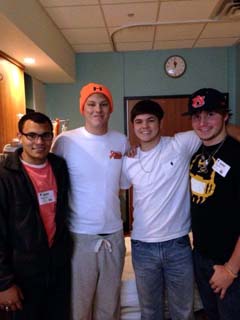
One such time fell during the National Peanut Festival—a local celebration honoring the crop that rebooted southeast Alabama’s agricultural economy after the boll weevil infestation devastated the cotton crops in the early 1900’s. Only six weeks after initial diagnosis and immunosuppressive treatment, Cody’s immune system was still weak, thus requiring him to take precautionary measures to prevent exposure to airborne illnesses. This didn’t stop Cody from donning a mask and joining his friends for a night of fun at the Peanut Festival, however.
“His friends didn’t want Cody to feel singled out so they all wore masks, too,” Frank says. “Cody told us that people stared at them, but his friends didn’t let that bother them. And one person even asked them why they were all wearing those masks,” he pauses in reflection before continuing, “Cody was slightly offended and told the guy ‘We’re all wearing these masks because I have cancer and my friends didn’t want me to have to wear one alone.’ He really had an amazing group of friends.”
In addition to having a weakened immune system affecting his daily routine, Cody also struggled with the reality of another one of chemotherapy’s side effects: hair loss.
“Cody also had such thick, beautiful hair.” Smiling reminiscently, Alicia recalls Cody’s concern about losing his perfectly coiffed brown locks due to the aggressive chemo treatments. “He would not let me shave it. He was determined to keep it for as long as he could get away with it.”
“Finally, on Christmas Eve, he looked at us and said ‘I’m ready,’ and we knew what he meant,” Cody’s father tearfully interjects. “So we finally shaved his head.”
In the dawning of 2014, the Hayes family would continue to fight, pray, hope, and research for a cure. Garnering support from countless members of the Ashford community, surrounding communities, and beyond through their Facebook page, “Staying Cody Strong,” they pressed forward in their pursuit of victory over this nightmare. On March 9th, after 101 rounds of chemo, Cody received his last treatment. Weeks later, Cody was able to go home to celebrate this milestone victory and hopefully resume a “normal” life in time to start his senior year in August. His return home, however, would prove to only be temporary.
By May, Cody’s cancer had relapsed.
“At first, Cody did not want to go back to Birmingham,” Alicia explains, “Finally, the doctors told him if he didn’t go back right then, he would certainly die within weeks.” Reluctantly, he took their advice and, once again, the Hayes family found themselves returning to Birmingham and pacing the all-too-familiar halls of Children’s Hospital.
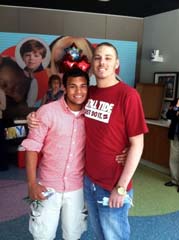
Even while being within the confines of a hospital room, Cody never lost his wit or his charm. Many of Frank and Alicia’s fondest memories include the numerous fellow cancer patients who became Cody’s friends. “One time, Cody, dressed in his doctor’s white jacket, paid a surprise visit to his friend.” Alicia pauses, smiling, “He walked into her room and said, ‘I’m here to cure you!’ Everyone in the room laughed.” Another happy memory was the birthday celebration the held for Cody’s birthday, which was May 23rd. Friends from school as well as friends among fellow patients and hospital staff gathered at the hospital to celebrate his 17th, and final birthday.
By early June, Cody’s condition began to worsen rapidly as his AML became chemo-resistant. “He was starting to exhibit stroke-like symptoms,” Alicia manages to continue tearfully, “His face…he couldn’t smile on one side. And he couldn’t move his extremities. And he was in a lot of pain due to the neuropathy.”
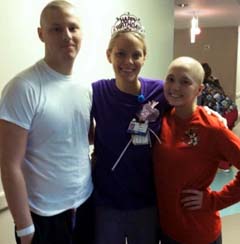
Clinging to every bit of hope, Cody’s parents researched various experimental treatment options, trying incessantly to get him into a new study. With their son’s health fading fast, Frank and Alicia knew they were racing against time, but they didn’t let that stop them from having faith. “There was hope as long as he was breathing,” Alicia says.
Their pursuit for a cure that would save their son’s life lead Frank, Alicia, and Cody to turn to their faith and reliance on God, more than ever before. They say the soul somehow knows what the body doesn’t—especially right before someone dies. On June 11th, Cody and his family took communion in his hospital room. “After taking communion, Cody asked me, ‘Daddy, am I going to die tomorrow?’” Frank tearfully recalls one his last conversations with his son, “I said ‘No, son.’ I thought we had more time!” He pauses briefly before adding, “He was always so thankful. When I’d help him up out of the bed, he’d kiss my cheek and say, ‘I love you, Daddy.’”
Later that night, it was decided that Cody should be moved to ICU. Before long, his condition worsened to where he could no longer swallow on his own. The precious borrowed time Cody had left was diminishing faster than anyone had prepared for. And before anyone had time to react, during a routine procedure, Cody experienced a vasovagal attack. Sometimes referred to as “vagalling out,” a vasovagal attack is a disorder that causes a rapid drop in heart rate and blood pressure, resulting in decreased blood flow to the brain.
“Vagalling happens many ways,” Alicia tearfully explains, “The nurse that night was using a small tube to suction out fluid that he (Cody) couldn’t swallow. She did it three times in a row. The third and last time, Cody was shaking his head ‘No,’ but she did it and then it happened. Cody vagalled and went into cardiac arrest.”
Weakened by the effects of AML, his body was not responsive to resuscitative measures administered by the nurses. And after 190 days in the hospital, 101 chemo treatments, 168 red blood transfusions, and countless prayers, Cody’s battle with cancer ended at 6:30 a.m. on June 12th 2014.
“He was the pride of my life,” Frank cries. “I think of him every time I hear Kenny Chesney’s song ‘There Goes My Life’. Because that’s what he was to me. I used to be afraid of dying, but not now. Now, I know my boy is waiting for me.”
“I used to think cancer would never affect my child; he was a healthy child. He was rarely ever sick!” Alicia’s voice starts to tremble, “We were still blessed. He was our miracle baby. We had tried for years and it wasn’t until we gave up that we finally got pregnant with Cody. When he was born, the doctor even held him up and said ‘That’s a miracle baby!’”
They say that pain is what lets us know we’re alive—that it’s what spurs us into action. For Frank and Alicia Hayes, the pain of losing their only child has prompted them to stay in motion, ministering to those afflicted by cancer.
When asked how they cope, Frank is quick to answer, “Jesus! Jesus is the only way I can get out of bed every day.” In addition to their faith, Alicia and Frank attribute staying busy. Through their website, stayingcodystrong.org, they continue telling their story, spreading awareness of childhood cancer, and raising funds for scholarships and childhood cancer research.
Cody may have lost his battle, but the war against childhood cancer is far from over. Thanks to the persevering efforts of people like Frank and Alicia Hayes, awareness is spreading, funds are being raised, and ground is being gained in the pursuit of a cure for this tragic disease. For more information on how you can help, visit www.stayingcodystrong.org.
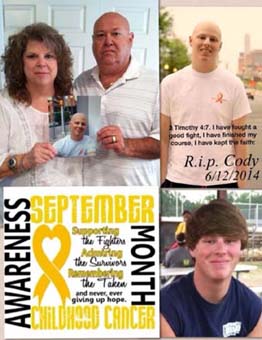
Related Thursday Review articles:
Dying to be Loved: The Final Footprints of Blake Coatney; Jennifer Walker-James; Thursday Review; September 12, 2015.
Bittersweet 16: The Harrowing Store of an Unsolved Case; Jennifer Walker-James; Thursday Review; August 1, 2015.
